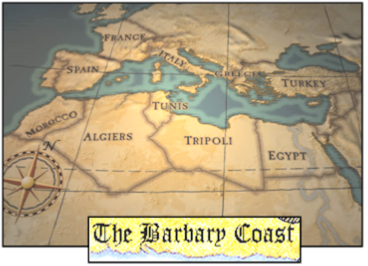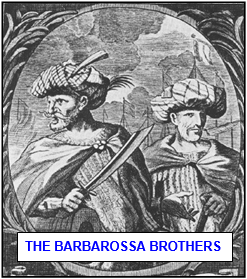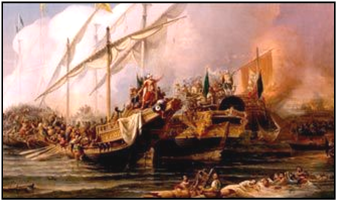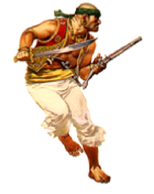


THE BARBARY PIRATES 1535 (H8)
xxxxxThe Barbary pirates, based along the North African coast, had been a menace to shipping from Roman times, but the real threat came early in the 16 century when the Moors asked for help from Selim, the Sultan of Turkey. Two Turkish corsairs, the Barbarossa brothers Arouj and Khair-
xxxxxThe Barbary pirates, based along the  North African coast from Libya (Tripoli) to Morocco, proved a serious danger to Mediterranean shipping as early as Roman times, and became particularly active during the 14th century, centred on the port of Bougie in north-
North African coast from Libya (Tripoli) to Morocco, proved a serious danger to Mediterranean shipping as early as Roman times, and became particularly active during the 14th century, centred on the port of Bougie in north-
xxxxxEarly in the new century, the Spaniards  retaliated by conquering the coastal towns of Oran, Algiers and Tunis, and then fortifying the island of Penon in the Bay of Algiers in 1514. Four years later, however, the Moors appealed to Selim, the sultan of Turkey, and the tables were turned. Hexcalled upon the services of two Turkish corsairs, Arouj and his brother Khair-
retaliated by conquering the coastal towns of Oran, Algiers and Tunis, and then fortifying the island of Penon in the Bay of Algiers in 1514. Four years later, however, the Moors appealed to Selim, the sultan of Turkey, and the tables were turned. Hexcalled upon the services of two Turkish corsairs, Arouj and his brother Khair-
xxxxxIt was to put an end to this constant menace  against his shipping in the Mediterranean that in 1535 the Holy Roman Emperor, Charles V, took a break from fighting the French in Italy and launched a naval attack upon Tunis. His forces managed to capture the port, together with Goletta, but his attempt to overthrow Khair-
against his shipping in the Mediterranean that in 1535 the Holy Roman Emperor, Charles V, took a break from fighting the French in Italy and launched a naval attack upon Tunis. His forces managed to capture the port, together with Goletta, but his attempt to overthrow Khair-
xxxxxIn the latter half of the 16th century,  despite further attempts by European powers to put an end to their activities, the corsairs stepped up their ferocious sorties, attacking Mediterranean coastal towns and villages to capture slaves -
despite further attempts by European powers to put an end to their activities, the corsairs stepped up their ferocious sorties, attacking Mediterranean coastal towns and villages to capture slaves -
xxxxxIncidentally, the name “Barbary” is derived from the “Berbers”, the earliest known inhabitants
of the North African coast. ……
xxxxx……xxThe port of Bougie, an early pirate settlement, was a flourishing trading centre, and introduced wax candles into Europe, hence the French word for candle, le bougie. ……
xxxxx……xxIt must be noted that whilst the Barbary Pirates were ferocious fighters and cruel masters, their Christian enemies had a somewhat similar reputation.



Acknowledgements
Map (North Africa): licensed under Creative Commons – pirates.wikia.com/wiki/Tripoli. Brothers: illustration on front cover of Pirates of the Mediterranean by the English historian John Malam, artist unknown. Preveza: by the Turkish artist Ohannes Umed Behzad, 1866 – Turkish Naval Museum, Istanbul.
H8-